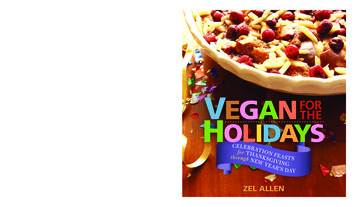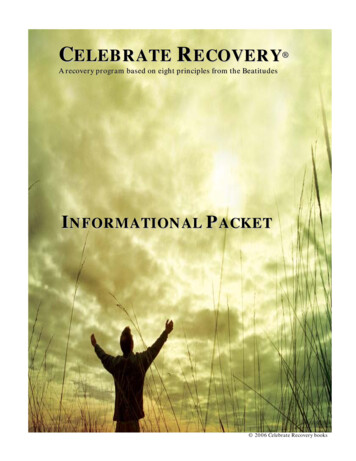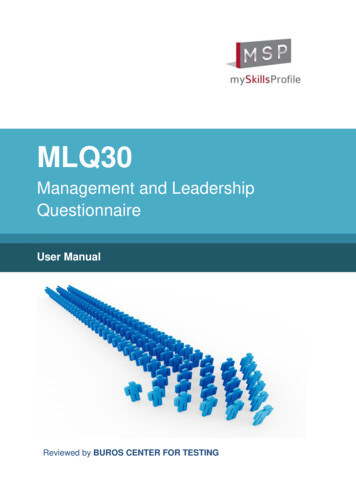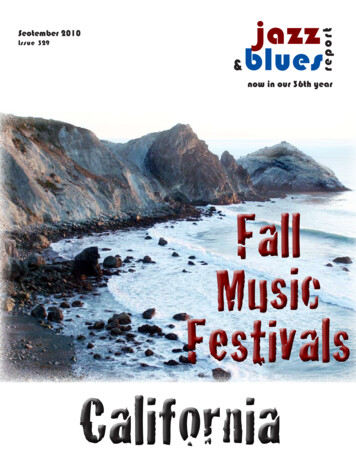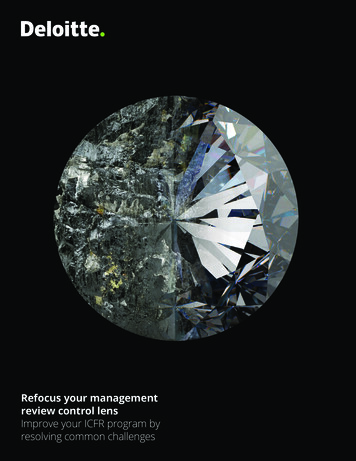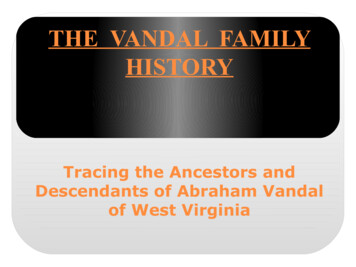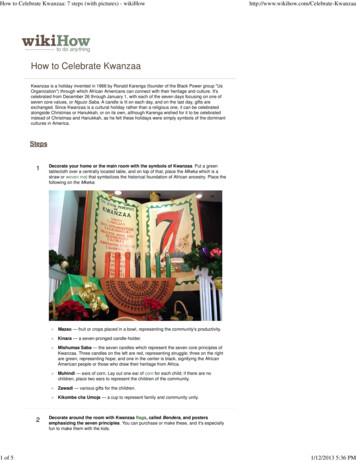
Transcription
How to Celebrate Kwanzaa: 7 steps (with pictures) - wikiHow1 of 5http://www.wikihow.com/Celebrate-KwanzaaHow to Celebrate KwanzaaKwanzaa is a holiday invented in 1966 by Ronald Karenga (founder of the Black Power group "UsOrganization") through which African Americans can connect with their heritage and culture. It'scelebrated from December 26 through January 1, with each of the seven days focusing on one ofseven core values, or Nguzo Saba. A candle is lit on each day, and on the last day, gifts areexchanged. Since Kwanzaa is a cultural holiday rather than a religious one, it can be celebratedalongside Christmas or Hanukkah, or on its own, although Karenga wished for it to be celebratedinstead of Christmas and Hanukkah, as he felt these holidays were simply symbols of the dominantcultures in America.Steps1Decorate your home or the main room with the symbols of Kwanzaa. Put a greentablecloth over a centrally located table, and on top of that, place the Mkeka which is astraw or woven mat that symbolizes the historical foundation of African ancestry. Place thefollowing on the Mkeka:Mazao — fruit or crops placed in a bowl, representing the community's productivity.Kinara — a seven-pronged candle-holder.Mishumaa Saba — the seven candles which represent the seven core principles ofKwanzaa. Three candles on the left are red, representing struggle; three on the rightare green, representing hope; and one in the center is black, signifying the AfricanAmerican people or those who draw their heritage from Africa.Muhindi — ears of corn. Lay out one ear of corn for each child; if there are nochildren, place two ears to represent the children of the community.Zawadi — various gifts for the children.Kikombe cha Umoja — a cup to represent family and community unity.2Decorate around the room with Kwanzaa flags, called Bendera, and postersemphasizing the seven principles. You can purchase or make these, and it's especiallyfun to make them with the kids.1/12/2013 5:36 PM
How to Celebrate Kwanzaa: 7 steps (with pictures) - wikiHow2 of 5See How to make a flag for details on flag making. Click hereinstructions on how to color in the r detailedIf you or your children enjoy making flags, try making African national or tribalin addition to the Bendera.3flagsPractice the Kwanzaa greetings. Starting on December 26, greet everyone by saying"Habari Gani" which is a standard Swahili greeting meaning "what is the news?" If someonegreets you, respond with the principle (Nguzo Saba) for that day:December 26: "Umoja" — UnityDecember 27: "Kujichagulia" — Self-determinationDecember 28: "Ujima" — Collective work and responsibilityDecember 29: "Ujamaa" — Cooperative economicsDecember 30: "Nia" — PurposeDecember 31: "Kuumba" — CreativityJanuary 1: "Imani" — Faith.Non African-Americans are also welcome to participate in greetings. The traditionalgreeting for them is "Joyous Kwanzaa."4Light the Kinara daily. Since each candle represents a specific principle, they are lit oneday at a time, in a certain order. The black candle is always lit first. Some people light theremaining candles from left to right (red to green) while other people alternate as follows:1/12/2013 5:36 PM
How to Celebrate Kwanzaa: 7 steps (with pictures) - wikiHow3 of 5http://www.wikihow.com/Celebrate-KwanzaaBlack candleFar left red candleFar right green candleSecond red candleSecond green candleLast red candleLast green candle5Celebrate Kwanzaa in a variety of different ways. Pick and choose some or all of thefollowing activities throughout the seven days of Kwanzaa, saving the feast for the sixthday. Kwanzaa ceremony may include:Drumming and musical selections.Readings of the African Pledge and the Principles of Blackness.Reflections on the Pan-African colors, discussions of African principles of the day, orrecitations of chapters in African history.The candle-lighting ritual of the Kinara.Artistic performances.Have the Kwanzaa Karamu (feast) on the sixth day (New Year's Eve). The Kwanzaa1/12/2013 5:36 PM
How to Celebrate Kwanzaa: 7 steps (with pictures) - wikiHow4 of 56http://www.wikihow.com/Celebrate-Kwanzaafeast is a very special event that brings everyone closer to their African roots. It istraditionally held on December 31st and is a communal and cooperative effort. Decorate theplace where the feast will be held in a red, green, and black scheme. A large Kwanzaasetting should dominate the room where the feast will be held. A large Mkeka should beplaced in the center of the floor where the food is placed creatively and made accessible toall to serve themselves. Before and during the feast, an informative and entertainingprogram should be presented.Traditionally, the program should involve welcoming, remembering, reassessment,recommitment and rejoicing, concluded by a farewell statement and a call for greaterunity.During the feast, libations are to be shared from a communal cup, the Kikombe chaUmoja, passed around to all celebrants.7Give out the gifts of Kuumba. Kuumba, meaning creativity, is highly encouraged andbrings a sense of self-satisfaction. The gifts are usually exchanged between the parentsand children and are given out traditionally on January 1st, the last day of Kwanzaa. Sincethe giving of gifts has very much to do with Kuumba, the gifts should be of an educational orartistic nature.Video1/12/2013 5:36 PM
How to Celebrate Kwanzaa: 7 steps (with pictures) - wikiHow5 of aa means "first fruits of the harvest" in the African language Kiswahili. Many of thephrases used in Kwanzaa are in Swahili, which was the language chosen to represent Africanheritage.Things You'll NeedMkeka (woven mat)Flag materialsCornGreen tableclothBlack, red, and green candlesGifts of different principlesRelated wikiHowsHow to Celebrate HanukkahHow to Celebrate ChristmasHow to Celebrate DiwaliHow to Be Proud to Be BlackHow to Find Long Lasting CandlesSources and Citationshttp://www.tike.com/celeb-kw.htm – research sourcehttp://www.melanet.com/kwanzaa/whatis.html – research sourcehttp://www.history.com/minisites/kwanzaa/ – research source1/12/2013 5:36 PM
KwanzaaThree Wikipedia ArticlesPDF generated using the open source mwlib toolkit. See http://code.pediapress.com/ for more information.PDF generated at: Sat, 12 Jan 2013 23:39:32 UTC
ContentsArticlesKwanzaa1Maulana Karenga5Co-operative economics10ReferencesArticle Sources and Contributors13Image Sources, Licenses and Contributors14Article LicensesLicense15
Kwanzaa1KwanzaaKwanzaa2003 Kwanzaa celebration with its founder, Maulana Karenga, and othersObserved byAfrican Americans, parts of African DiasporaTypeCultural and ethnicSignificanceCelebrates African heritage, unity and culture.DateDecember 26 to January 1CelebrationsUnitySelf-DeterminationCollective Work and ResponsibilityCooperative EconomicsPurposeCreativityFaithRelated toPan-AfricanismKwanzaa is a week-long celebration held in the United States and also celebrated in the Western African Diasporain other nations of the Americas. The celebration honors African heritage in African-American culture, and isobserved from December 26 to January 1, culminating in a feast and gift-giving.[1] Kwanzaa has seven coreprinciples (Nguzo Saba): Unity, self-determination, collective work and responsibility, cooperative economics,purpose, creativity, and faith. It was created by Maulana Karenga, and was first celebrated in 1966–67.History and etymologyMaulana Karenga created Kwanzaa in 1966 as the first specifically African-American holiday.[2] Karenga said hisgoal was to "give Blacks an alternative to the existing holiday and give Blacks an opportunity to celebratethemselves and their history, rather than simply imitate the practice of the dominant society."The name Kwanzaaderives from the Swahili phrase matunda ya kwanza, meaning first fruits of the harvest. The choice of Swahili, anEast African language, reflects its status as a symbol of Pan-Africanism, especially in the 1960s, despite the fact thatmost East African nations were not involved in the Atlantic slave trade that brought African people to America.[3]Kwanzaa was a celebration that has its roots in the black nationalist movement of the 1960s, and was established as ameans to help African Americans reconnect with their African cultural and historical heritage by uniting inmeditation and study of African traditions and Nguzu Saba, the "seven principles of African Heritage" whichKarenga said "is a communitarian African philosophy".During the early years of Kwanzaa, Karenga said that it was meant to be an alternative to Christmas, that Jesus waspsychotic, and that Christianity was a white religion which black people should shun.[4] However, as Kwanzaagained mainstream adherents, Karenga altered his position so that practicing Christians would not be alienated, thenstating in the 1997 Kwanzaa: A Celebration of Family, Community, and Culture, "Kwanzaa was not created to give
Kwanzaa2people an alternative to their own religion or religious holiday."[5]Many Christian African Americans who celebrate Kwanzaa do so in addition to observing Christmas.[6]Principles and symbolsKwanzaa celebrates what its founder called the seven principles of Kwanzaa, or Nguzo Saba (originally NguzuSaba—the seven principles of African Heritage), which Karenga said "is a communitarian African philosophy,"consisting of what Karenga called "the best of African thought and practice in constant exchange with the world."These seven principles comprise *Kawaida, a Swahili term for tradition and reason. Each of the seven days ofKwanzaa is dedicated to one of the following principles, as follows: Umoja (Unity): To strive for and to maintain unity in the family, community, nation, and race. Kujichagulia (Self-Determination): To define ourselves, name ourselves, create for ourselves, and speak forourselves. Ujima (Collective Work and Responsibility): To build and maintain our community together and make ourbrothers' and sisters' problems our problems, and to solve them together. Ujamaa (Cooperative Economics): To build and maintain our own stores, shops, and other businesses and toprofit from them together. Nia (Purpose): To make our collective vocation the building and developing of our community in order to restoreour people to their traditional greatness. Kuumba (Creativity): To do always as much as we can, in the way we can, in order to leave our community morebeautiful and beneficial than we inherited it. Imani (Faith): To believe with all our hearts in God, our people, our parents, our teachers, our leaders, and therighteousness and victory of our struggle.Kwanzaa symbols include a decorative mat on which other symbols are placed, corn and other crops, a candle holderwith seven candles, called a kinara, a communal cup for pouring libations, gifts, a poster of the seven principles, anda black, red, and green flag. The symbols were designed to convey the seven principles.[7]ObservanceFamilies celebrating Kwanzaa decorate their households with objectsof art; colorful African cloth such as kente, especially the wearing ofkaftans by women; and fresh fruits that represent African idealism. It iscustomary to include children in Kwanzaa ceremonies and to giverespect and gratitude to ancestors. Libations are shared, generally witha common chalice, Kikombe cha Umoja, passed around to allcelebrants. Non-African Americans also celebrate Kwanzaa.[8] Theholiday greeting is "Joyous Kwanzaa".[9][10][11]A Kwanzaa ceremony may include drumming and musical selections,libations, a reading of the African Pledge and the Principles ofBlackness, reflection on the Pan-African colors, a discussion of theAfrican principle of the day or a chapter in African history, a candle-lighting ritual, artistic performance, and, finally,a feast (karamu). The greeting for each day of Kwanzaa is Habari Gani?[12] which is Swahili for "What's theNews?"[13]A woman lighting kinara candlesAt first, observers of Kwanzaa avoided the mixing of the holiday or its symbols, values, and practice with otherholidays, as doing so would violate the principle of kujichagulia (self-determination) and thus violate the integrity ofthe holiday, which is partially intended as a reclamation of important African values. Today, many African Americanfamilies celebrate Kwanzaa along with Christmas and New Year's. Frequently, both Christmas trees and kinaras, the
Kwanzaa3traditional candle holder symbolic of African American roots, share space in Kwanzaa-celebrating households. Forpeople who celebrate both holidays, Kwanzaa is an opportunity to incorporate elements of their particular ethnicheritage into holiday observances and celebrations of Christmas.Cultural exhibitions include the Spirit of Kwanzaa, an annual celebration held at the John F. Kennedy Center for thePerforming Arts featuring interpretive dance, African dance, song and poetry.[14][15]The first Kwanzaa stamp was issued by the United States PostalService on October 22, 1997, with artwork by Synthia Saint James.[16]In 2004, a second Kwanzaa stamp, designed by Daniel Minter, wasissued; this has seven figures in colorful robes symbolizing the sevenprinciples.[17]The holiday has also spread to Canada, and is celebrated by BlackCanadians in a similar fashion as in America.[18]PopularityThe first U.S. postage stamp commemoratingKwanzaa, issued in 1997. Artwork by SynthiaSaint James.In 2004, BIG Research conducted a marketing survey in the UnitedStates for the National Retail Foundation, which found that 1.6% ofthose surveyed planned to celebrate Kwanzaa. If generalized to the USpopulation as a whole, this would imply that around 4.7 million people planned to celebrate Kwanzaa in that year.[19]In a 2006 speech, Ron Karenga asserted that 28 million people celebrate Kwanzaa. He has always claimed it iscelebrated all over the world.[1] Lee D. Baker puts the number at 12 million.[20] The African American CulturalCenter claimed 30 million in 2009.[21] In 2011, Keith Mayes said that 2 million people participated in Kwanzaa.[21]According to Keith Mayes, the author of Kwanzaa: Black Power and the Making of the African-American HolidayTradition, the popularity within the US has "leveled off" as the black power movement there has declined, and nowbetween half and two million people celebrate Kwanzaa in the US, or between one and five percent of AfricanAmericans. Mayes adds that white institutions now celebrate it.[8]The holiday has also spread to Canada, and is celebrated by Black Canadians in a similar fashion as in the UnitedStates.[18] According to the Language Portal of Canada, "this fairly new tradition has [also] gained in popularity inFrance, Great Britain, Jamaica and Brazil", although this information has not been confirmed with authoritativesources from these countries.[22]In Brazil, in recent years the term Kwanzaa has been applied by a few institutions as a synonym for the festivities ofthe Black Awareness Day, commemorated on November 20 in honor of Zumbi dos Palmares,[23][24] having little todo with the celebration as it was originally conceived.In 2009, Maya Angelou narrated the documentary The Black Candle, a film about Kwanzaa.References[1] "Why Kwanzaa Video" (http:/ / www. africanholocaust. net/ news ah/ kwanzaa. html). "Ron Karenga". .[2] Alexander, Ron (1983-12-30). "The Evening Hours" (http:/ / select. nytimes. com/ search/ restricted/article?res F00B1EFD395C0C738FDDAB0994DB484D81). New York Times". . Retrieved 2006-12-15.[3] http:/ / books. google. co. za/ books?id 1rHLyC2yHQ8C& q Mozambique#v snippet& q Mozambique& f false The Atlantic Slave TradeBy Herbert S. Klein Klein[4] Karenga, Maulana (1967). "Religion" (http:/ / www. piratepundit. com/ karenga6. html). In Clyde Halisi, James Mtume. The quotableKarenga. Los Angeles: University of Sankore Press. pp. 25. 23769.8. .[5] J. Lawrence Scholer, " The story of Kwanzaa (http:/ / web. archive. org/ web/ 20080401093652/ http:/ / dartreview. com/ archives/ 2001/ 01/15/ the story of kwaanza. php)", Dartmouth Review, 15 January 2001.[6] Williams, Lena (1990-12-20). "In Blacks' Homes, the Christmas and Kwanzaa Spirits Meet" (http:/ / www. nytimes. com/ 1990/ 12/ 20/garden/ meet. html?pagewanted 1). The New York Times. . Retrieved 2010-05-07.[7] "The Symbols of Kwanzaa" (http:/ / www. officialkwanzaawebsite. org/ symbols. shtml). . Retrieved 2010-12-24.
Kwanzaa[8] Keith Mayes, cited by Megan K. Scott, " Kwanzaa celebrations continue, but boom is over (http:/ / web. archive. org/ web/ 20091220052310/http:/ / www. buffalonews. com/ 260/ story/ 897568. html)", Buffalo News, 17 December 2009. Accessed 25 December 2009.[9] Bush, George W. (2004-12-23). "Presidential Kwanzaa Message, 2004" (http:/ / georgewbush-whitehouse. archives. gov/ news/ releases/2004/ 12/ 20041223-2. html). Office of the Press Secretary. . Retrieved 2007-12-24.[10] "Clinton offers holiday messages" (http:/ / www. cnn. com/ ALLPOLITICS/ 1997/ 12/ 23/ message/ ). CNN. 1997-12-23. . Retrieved2007-12-24.[11] Gale, Elaine (1998-12-26). "Appeal of Kwanzaa continues to grow; holidays: today marks start of the seven-day celebration of Africanculture, which began in Watts 32 years ago and is now observed by millions." (http:/ / pqasb. pqarchiver. com/ latimes/ access/ 37610058.html?dids 37610058:37610058& FMT ABS& FMTS ABS:FT& date Dec 26, 1998& author ELAINE GALE& pub Los Angeles Times& desc Appeal of Kwanzaa Continues to Grow; Holidays: Today marks start of the seven-day celebration of African culture, which began in Watts 32 years ago and is now observed by millions. & pqatl google). Los AngelesTimes. . Retrieved 2007-12-24.[12] Offical Kwanzaa site Greeting (http:/ / www. officialkwanzaawebsite. org/ greetings and. shtml)[13] Swahili Meaning (http:/ / www. omniglot. com/ language/ phrases/ swahili. php)[14] The Spirit of Kwanzaa (http:/ / www. kennedy-center. org/ calendar/ index. cfm?fuseaction showEvent& past true& event RHXAP)[15] The Dance Institute of Washington (http:/ / www. danceinstitute. org/ aboutus3g. html)[16] Bringing Good Into the World (http:/ / www. officialkwanzaawebsite. org/ kwanzaastamp. shtml)[17] Kwanzaa featured on this year's holiday U.S. postage stamp (http:/ / www. usps. com/ communications/ news/ stamps/ 2004/ sr04 070. htm)[18] "The principles of Kwanzaa" (http:/ / archives. cbc. ca/ society/ celebrations/ clips/ 16226/ ). CBC. Broadcast Date: Dec. 28, 1993. .Retrieved 2011-12-16.[19] "2004 Holiday Spending by Region" (http:/ / web. archive. org/ web/ 20041118072528/ http:/ / www. nrf. com/ content/ default.asp?folder press/ holiday& file HolidayRegion1004. htm), 'Survey by BIGresearch, conducted for National Retail Foundation', 14 October2004[20] Manning Marable, Dispatches from the Ebony Tower, p. 224.[21] " Kwanzaa celebration unites African-American community (http:/ / thepost. ohiou. edu/ n-community)", The Post, Ohio University, 1 November 2011. Accessed 25 December 2012.[22] "Celebrate Kwanzaa!" (http:/ / www. noslangues-ourlanguages. gc. ca/ bien-well/ fra-eng/ vocabulaire-vocabulary/ clbrt-kwanzaa-eng.html). Government of Canada. Date Modified: 2011-02-21. . Retrieved 2011-12-16.[23] Celebration of Kwanzaa (http:/ / www. prefeitura. sp. gov. br/ portal/ a cidade/ noticias/ index. php?p 5702) on Black Awareness Day inSão Paulo.[24] Celebration of Kwanzaa (http:/ / www. cultura. ba. gov. br/ 2011/ 10/ adania-e-valorizacao-da-cultura-afro/ ) on the 28th anniversary of Olodum School inSalvador, Bahia.External links The Official Kwanzaa Web Site )The Black Candle: a Kwanzaa film narrated by Maya Angelou (http://www.theblackcandle.com)Why Kwanzaa was created by Karenga (http://www.africanholocaust.net/news ah/kwanzaa.html)The History Channel: Kwanzaa wanzaa/)Interview yId 1571259): Karenga discusses the evolutionof the holiday and its meaning. Tavis Smiley (NPR) Kwanzaa at History.com (http://www.history.com/topics/kwanzaa-history) Camille Jackson, " Kwanzaa: A threat to Christmas? (http://ndn.nigeriadailynews.com/templates/?a 1642)",Nigeria Daily News, 23 December 2005.4
Maulana Karenga5Maulana KarengaMaulana KarengaKarenga, center, with wife Tiamoyo at left, celebrating Kwanzaa at the Rochester Institute of Technology on December 12, 2003BornRonald McKinley EverettJuly 14, 1941Parsonsburg, olarSpouse(s)Brenda Lorraine "Haiba" Karenga (Divorced)Tiamoyo Karenga (1970-present)Websitehttp:/ / www. maulanakarenga. org/Maulana Ndabezitha Karenga (born Ronald McKinley Everett[2][3][4] on July 14, 1941) is an African-Americanprofessor of Africana Studies, activist and author, best known as the creator of the pan-African andAfrican-American holiday of Kwanzaa. Karenga was a major figure in the Black Power movement of the 1960s and1970s and co-founded with Hakim Jamal the black nationalist and social change organization US.Early lifeRon Everett was born in Parsonsburg, Maryland, the fourteenth child and seventh son in the family. His father was atenant farmer and Baptist minister who employed the family to work fields under an effective sharecroppingarrangement.[5] Everett moved to Los Angeles in 1959, joining his older brother who was a teacher there, andattended Los Angeles City College (LACC). He became active with civil rights organizations CORE and SNCC,took an interest in African studies, and was elected as LACC's first African-American student president.[6] Afterearning his associate degree, he matriculated at the University of California, Los Angeles (UCLA) and earned B.A.and M.A. degrees in political science. He studied Swahili, Arabic and other African-related subjects. Among hisinfluences at UCLA were Jamaican anthropologist and Negritudist Councill Taylor who contested the Eurocentricview of alien cultures as primitive.[7] During this period he took the name Karenga (Swahili for "keeper oftradition") and the title Maulana (Swahili-Arabic for "master teacher").[5] While pursuing his doctorate at UCLA, hetaught African culture classes for local African-Americans and joined a study group called the Circle of Seven.
Maulana Karenga1960s activismUSThe Watts uprising broke out as Karenga was a year into his doctoral studies. Karenga and the Circle of Sevenestablished a community organization in the aftermath called US (meaning "Us black people").[8] The organizationjoined in several community revival programs and was featured in press reports. Karenga cited Malcolm X'sAfro-American Unity program as an influence on the US organization's work:Malcolm was the major African American thinker that influenced me in terms of nationalism andPan-Africanism. As you know, towards the end, when Malcolm is expanding his concept of Islam, andof nationalism, he stresses Pan-Africanism in a particular way. And he argues that, and this is where wehave the whole idea that cultural revolution and the need for revolution, he argues that we need acultural revolution, he argues that we must return to Africa culturally and spiritually, even if we can’t gophysically. And so that’s a tremendous impact on US.[9]As racial disturbances spread across the country, Karenga appeared at a series of black power conferences, joiningother groups in urging the establishment of a separate political structure for African-Americans.US became a target of the FBI's COINTELPRO and was put on a series of lists describing it as dangerous,revolutionary and committed to armed struggle in the Black Power Movement.[10] US developed a youth componentwith para-military aspects called the Simba Wachanga which advocated and practiced community self-defense andservice to the masses.KwanzaaKarenga created Kwanzaa in 1966[11] to be the first pan-African holiday. He said his goal was to "give Blacks analternative to the existing holiday and give Blacks an opportunity to celebrate themselves and their history, ratherthan simply imitate the practice of the dominant society."[12] It is inspired by African "first fruit" traditions, and thename is derived from the name for the Swahili first fruit celebration, “matunda ya kwanza.” [13] The rituals of theholiday promote African traditions and Nguzo Saba, the "seven principles of African Heritage" which Karengadescribed as "a communitarian African philosophy": Umoja (unity)—To strive for and maintain unity in the family, community, nation, and race. Kujichagulia (self-determination)—To define ourselves, name ourselves, create for ourselves, and speak forourselves. Ujima (collective work and responsibility)—To build and maintain our community together and make ourbrother's and sister's problems our problems and to solve them together. Ujamaa (cooperative economics)—To build and maintain our own stores, shops, and other businesses and toprofit from them together. Nia (purpose)—To make our collective vocation the building and development of our community in order torestore our people to their traditional greatness. Kuumba (creativity)—To do always as much as we can, in the way we can, in order to leave our community morebeautiful and beneficial than we inherited it. Imani (faith)—To believe with all our heart in our people, our parents, our teachers, our leaders, and therighteousness and victory of our struggle.6
Maulana KarengaConflict with the Black Panther PartyUS engaged in violent competition with the Black Panther Party in their claim to be a revolutionary vanguard. Thisheightened level of conflict eventually led to a shoot-out at UCLA in 1969 in which two Panthers were killed and aSimba was shot in the back. Following the UCLA shootout, Panthers and US members carried out a series ofretaliatory shootings that resulted in at least two more murders of Panthers.[14]The FBI attempted to aggravate the conflict. Tactics used to foment and aggravate conflict between US and thePanthers included poison-pen letters, defamatory cartoons, agents provocateurs, and creating suspicion of membersof each organization as agents.[15]Conviction for assaultIn 1971, Karenga was sentenced to one to ten years in prison on counts of felonious assault and falseimprisonment.[16] One of the victims gave testimony of how Karenga and other men tortured her and anotherwoman. The woman described having been stripped and beaten with an electrical cord. Karenga's estranged wife,Brenda Lorraine Karenga, testified that she sat on the other woman’s stomach while another man forced water intoher mouth through a hose.A May 14, 1971, article in the Los Angeles Times described the testimony of one of the women:"Deborah Jones, who once was given the Swahili title of an African queen, said she and Gail Davis werewhipped with an electrical cord and beaten with a karate baton after being ordered to remove theirclothes. She testified that a hot soldering iron was placed in Miss Davis' mouth and placed against MissDavis' face and that one of her own big toes was tightened in a vise. Karenga, head of US, also putdetergent and running hoses in their mouths, she said. They also were hit on the heads with toasters."[17]Jones and Brenda Karenga testified that Karenga believed the women were conspiring to poison him, which Davishas attributed to a combination of ongoing police pressure and his own drug abuse.[5][18]Karenga denied any involvement in the torture, and argued that the prosecution was political in nature.[5][19] He wasimprisoned at the California Men's Colony, where he studied and wrote on feminism, Pan-Africanism and othersubjects. The US organization fell into disarray during his absence and was disbanded in 1974. After he petitionedseveral black state officials to support his parole on fair sentencing grounds, it was granted in 1975.[20]Karenga has declined to discuss the convictions with reporters and does not mention them in biographicalmaterials.[18] During a 2007 appearance at Wabash College he again denied the charges and described himself as aformer political prisoner.[21] The convictions nonetheless continue to generate controversy during Kwanzaacelebrations.[18]Later careerAfter his parole Karenga re-established the US organization under a new structure. He was awarded his first Ph.D. in1976 from United States International University (now known as Alliant International University) for a 170-pagedissertation entitled Afro-American Nationalism: Social Strategy and Struggle for Community. Later in his career, in1994, he was awarded a second Ph.D., in social ethics, from the University of Southern California (USC), for an803-page dissertation entitled "Maat, the moral ideal in ancient Egypt: A study in classical African ethics."In 1977, he formulated a set of principles called Kawaida, a Swahili term for normal. Karenga called on AfricanAmericans to adopt his secular humanism and reject other practices as mythical (Karenga 1977, pp. 14, 23, 24, 27,44–5).Karenga is the Chair of the Africana Studies Department at California State University, Long Beach. He is thedirector of the Kawaida Institute for Pan African Studies and the author of several books, including his "Introductionto Black Studies", a comprehensive Black/African Studies textbook now in its fourth edition. He is also known for7
Maulana Karengahaving co-hosted, in 1984, a conference that gave rise to the Association for the Study of Classical AfricanCivilizations, and in 1995, he sat on the organizing committee and authored the mission statement of the MillionMan March.Karenga delivered a eulogy at the 2001 funeral service of New Black Panther Party leader Khalid AbdulMu
Black candle Far left red candle Far right green candle Second red candle Second green candle Last red candle Last green candle Celebrate Kwanzaa in a variety of different ways. Pick and choose some or all of the following activities throughout the seven days of Kwanzaa, saving t

